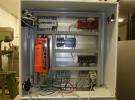Hello,
We bought a Labjack T7 with expansion board B37 for logging analog signals as well as pulse signals to get flow from Hall sensors. Analog signals are no problem, but we have problems to configure more than two pulse signals. The frequency is very low <100 Hz, and we need to read 5 pulse signals simultaniously. How many pulse signals in this way (Hall sensors, Voltage 2,8..24V) we can read at all? How to configure?
Thanks, Stefan



.png%3Fitok=PHGBxf6M)


.jpg%3Fitok=B1YcuDFK)
.png%3Fitok=Ybt-OlgU)
Stefan,
Since you are trying to read data from more than 5 pulse signals simultaneously, which excedes the number of timers & counters on the T7. I suggest you connect them to analog inputs and then read them through the registers AIN0 -> AIN4. You can do this in LJLogM or LJStreamM to save the data to a file for later analysis, use DAQFactory to read the data and add your own custom logic, or you can write your own program starting with some of our example code in python or another language compatible with the T7.
Stefan,
Since you are trying to read data from more than 5 pulse signals simultaneously, which excedes the number of timers & counters on the T7. I suggest you connect them to analog inputs and then read them through the registers AIN0 -> AIN4. You can do this in LJLogM or LJStreamM to save the data to a file for later analysis, use DAQFactory to read the data and add your own custom logic, or you can write your own program starting with some of our example code in python or another language compatible with the T7.
Hello support,
does that mean that we can only use two inputs for impulse signals on the digital inputs? We already use all analog inputs...
First decide if you want to time pulses or count pulses. With your low frequency timing individual pulses is likely what you want, but if you really needed more inputs you could use counting and we have an example Lua script that does counting on all DIO and even AIN:
https://forums.labjack.com/index.php?showtopic=1105
Even with timing, though, your frequency is low enough that you can use the interrupt features so you have up to 6 channels available for timing pulses. See Table 13.2-2 and check out Interrupt Frequency In:
https://labjack.com/support/datasheets/t-series/digital-io/extended-features
To get started go through the counter tutorial. Counting is the simplest way to get started and an easy way to test whether your signals are electrically valid:
https://labjack.com/support/software/applications/t-series/kipling/register-matrix/counter-example
When you get to the section "Connecting your Signal to a Counter" you can test each of your signals to confirm they give counts. Note that if your signals are driving over 5 volts you need to do something as discussed in "Driven Signals" (the LJTD is a likely solution).